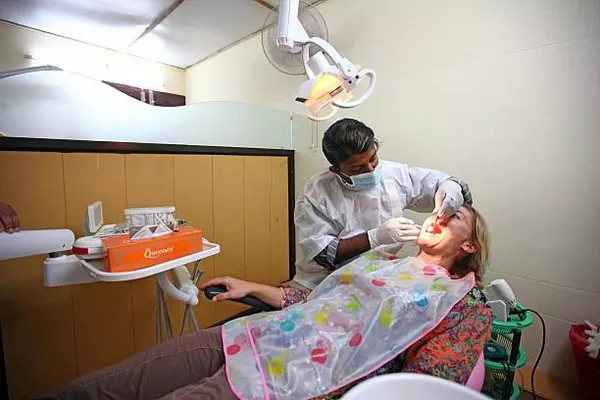Maintaining good oral hygiene is essential for keeping your teeth and gums healthy. Brushing and flossing twice a day, as well as regular dental checkups, are the primary ways to keep your teeth clean. However, if you neglect your oral hygiene, plaque can build up on your teeth and harden into tartar, which can lead to gum disease and other dental problems. In such cases, deep cleaning may be necessary to remove the buildup of tartar and bacteria. In this article, we will discuss what deep cleaning is and how it is done.
Introduction to Deep Cleaning
Deep cleaning, also known as scaling and root planing, is a dental procedure that involves removing plaque, tartar, and bacteria from the teeth and gums. This procedure is usually performed by a dental hygienist or periodontist and is recommended for patients who have signs of gum disease, such as redness, swelling, bleeding, or recession of the gums. Deep cleaning can help prevent further damage to the gums and teeth and reduce the risk of tooth loss.
The Deep Cleaning Procedure
The deep cleaning procedure involves two main steps: scaling and root planing. These procedures are usually done in one visit but may require multiple visits depending on the severity of the patient’s condition.
Scaling
Scaling involves the removal of plaque and tartar from the teeth using a special tool called a scaler. The scaler scrapes away the buildup of plaque and tartar from the surface of the teeth and under the gum line. The process may cause some discomfort, especially if the patient has sensitive teeth or gums. To reduce discomfort, a local anesthetic may be used to numb the area before the procedure.
Root Planing
After scaling, root planing is done to smooth out the rough surfaces of the roots of the teeth. This helps to prevent the buildup of plaque and tartar in the future. Root planing also removes any bacterial toxins that may be present on the roots of the teeth, which can help to reduce inflammation and promote healing of the gums.
Recovery
After the deep cleaning procedure, patients may experience some discomfort or sensitivity in their teeth and gums for a few days. Over-the-counter pain relievers such as ibuprofen or acetaminophen can help to alleviate any discomfort. Patients should also avoid smoking, drinking alcohol, and eating hard or crunchy foods for a few days after the procedure to allow the gums to heal properly.
Follow-Up Care
To maintain good oral hygiene and prevent further gum disease, patients should follow a strict oral care routine after the deep cleaning procedure. This includes brushing twice a day and flossing once a day, as well as using an antibacterial mouthwash to kill any remaining bacteria in the mouth. Patients should also schedule regular dental checkups and cleanings every six months to monitor the health of their gums and teeth.
Is a deep teeth cleaning painful?
Deep teeth cleaning, also known as scaling and root planing, can be slightly uncomfortable for some patients but it shouldn’t be painful. During the procedure, your dentist or dental hygienist will use specialized instruments to clean beneath the gum line and remove plaque and tartar buildup that can lead to gum disease. They may also smooth out any rough spots on the tooth roots to help prevent further buildup.
To ensure your comfort during the procedure, your dentist or dental hygienist may use a local anesthetic to numb the area being worked on. After the procedure, you may experience some mild discomfort or sensitivity to hot and cold temperatures, but this should subside within a few days. If you have concerns about the procedure or are experiencing any pain, be sure to speak with your dentist or dental hygienist.
Why are dentists pushing deep cleaning?
Dentists may recommend deep cleaning, also known as scaling and root planing, for a few reasons. The primary reason is to treat and prevent gum disease, which is a common dental problem that can lead to tooth loss if left untreated.
Gum disease occurs when plaque and tartar buildup on the teeth and gums, causing inflammation and infection. If left untreated, it can progress to more severe stages and cause damage to the bones and tissues supporting the teeth. Deep cleaning helps remove the buildup of plaque and tartar from beneath the gum line, where regular brushing and flossing cannot reach, and smooths out the rough spots on the roots of teeth, making it harder for bacteria to re-adhere.
Another reason why dentists may recommend deep cleaning is to prepare the mouth for other dental procedures, such as placing dental implants or treating periodontal pockets.
It’s important to note that while some dentists may recommend deep cleaning more frequently than others, it’s always important to follow their recommendations and maintain good oral hygiene habits to keep your teeth and gums healthy.
Conclusion
Deep cleaning is an essential dental procedure for maintaining good oral hygiene and preventing gum disease. It involves the removal of plaque, tartar, and bacteria from the teeth and gums through scaling and root planing. Patients may experience some discomfort or sensitivity after the procedure, but this typically resolves within a few days. To maintain healthy teeth and gums, patients should follow a strict oral care routine and schedule regular dental checkups and cleanings. If you are experiencing signs of gum disease, consult your dentist to determine if deep cleaning is right for you.
Related Topics:





























